Forensic scientists have to work often with extremely small samples of DNA obtained from the hair or other sources of suspected criminals. However, it is possible to produce DNA 'fingerprint' from these small samples by using
gene gun
gene cloning
polymerase chain reaction
genetically engineered microorganisms
The correct Answer is:c
Step by step video, text & image solution for Forensic scientists have to work often with extremely small samples of DNA obtained from the hair or other sources of suspected criminals. However, it is possible to produce DNA 'fingerprint' from these small samples by using by Biology experts to help you in doubts & scoring excellent marks in Class 12 exams.
Topper's Solved these Questions
- BOOK - ARIHANT NEETCHAPTER - BIOTECHNOLOGY : PRINCIPLES AND PROCESSESEXERCISE - B) Medical entrances special format questions (Statement based questions )1videos
BIOTECHNOLOGY : PRINCIPLES AND PROCESSES
- BOOK - ARIHANT NEETCHAPTER - BIOTECHNOLOGY : PRINCIPLES AND PROCESSESEXERCISE - Chapter exercises (B. Medical entrances special format questions (Statement based questions))3videos
BIOTECHNOLOGY : PRINCIPLES AND PROCESSES
- BOOK - ARIHANT NEETCHAPTER - BIOTECHNOLOGY : PRINCIPLES AND PROCESSESEXERCISE - Check point 21.515videos
BIOTECHNOLOGY : PRINCIPLES AND PROCESSES
- BOOK - ARIHANT NEETCHAPTER - BIOMOLECULES AND ENZYMESEXERCISE - Chapter Exercises (C) Medical Entraces gallery (Collection of questions asked in NEET & Various Medical Entrance Exams)62videos
BIOMOLECULES AND ENZYMES
- BOOK - ARIHANT NEETCHAPTER - BIOTECHNOLOGY AND ITS APPLICATIONS EXERCISE - CHAPTER EXERCISES ((C ) MEDICAL ENTRANCES GALLERY )46videos
BIOTECHNOLOGY AND ITS APPLICATIONS
Similar Questions
Answer the following questions based on Meselson and Stahl s experiment: (a) Write the name of the chemical substance used as a source of nitrogen in the experiment by them. (b) Why did the scientists synthesise the light and the heavy DNA molecules In the organism used in the experiment ? (c) How did the scientists make it possible to distinguish the heavy DNA molecule from the light DNA molecule ? Explain. ((1) Write the conclusion the scientists arrived at after completing the experiment.
View SolutionDuring a murder trial two suspects appeared before court . After an investigation (which included DNA fingerprinting) the available evidence proved that suspect A was the murderer. This suspect said that the he was innocent and that his identical twin brother , still on the loose, was in fact the guilty person. His twin brother was subjected to DNA fingerprint tests. Study the DNA fingerprints of hair samples and answer the questions given below:
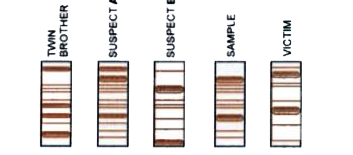
What is this type of investigation( Where DNA fingerprints are involved ) called ?View Solution
Knowledge Check
- Question 1 - Select One
Study the information below and answer questions based on it.
Recently, the answers of a test held nation wide were leaked to a group of unscrupulous people. The investigative agency has arrested the mastermind and nine other people A, B, C, D, E, F, G, H and I in this matter. Interrogating them, the following facts have been obtained regarding their operation. Initially the mastermind obtains the correct answer-key. All the others create their answer-key in the following manner. They obtain the answer key from one or two people who already possess the same. The people are called his/her "sources". If the person has two sources, then he/she compares the answer-keys obtained from both sources. If the key to a question from both sources is identical, it is copied, otherwise it is left blank. If the person has only one source, he/she copies the source's answers into his/her copy. Finally, each person compulsorily replaces one of the answers (not a blank one) with a wrong answer in his/her answer key.
The paper contained 200 questions, so the investigative agency has ruled out the possibility of two or more of them introducing wrong answers to the same question. The investigative agency has a copy of the correct answer key and has tabulated the following data. These data represent question numbers.
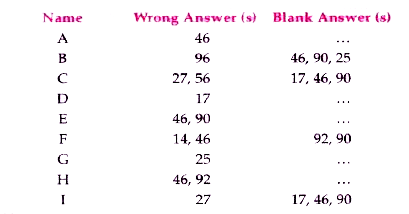
Both G and H were sources toAFBBCIDNone of these - Question 2 - Select One
Study the information below and answer questions based on it.
Recently, the answers of a test held nation wide were leaked to a group of unscrupulous people. The investigative agency has arrested the mastermind and nine other people A, B, C, D, E, F, G, H and I in this matter. Interrogating them, the following facts have been obtained regarding their operation. Initially the mastermind obtains the correct answer-key. All the others create their answer-key in the following manner. They obtain the answer key from one or two people who already possess the same. The people are called his/her "sources". If the person has two sources, then he/she compares the answer-keys obtained from both sources. If the key to a question from both sources is identical, it is copied, otherwise it is left blank. If the person has only one source, he/she copies the source's answers into his/her copy. Finally, each person compulsorily replaces one of the answers (not a blank one) with a wrong answer in his/her answer key.
The paper contained 200 questions, so the investigative agency has ruled out the possibility of two or more of them introducing wrong answers to the same question. The investigative agency has a copy of the correct answer key and has tabulated the following data. These data represent question numbers.
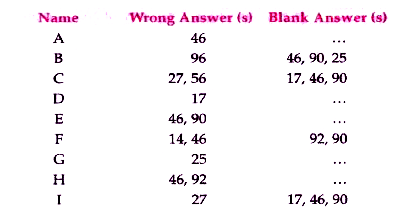
Which of the following statements is true ?AC introduced the wrong answer to question 27BE introduced the wrong answer to question 46CF introduced the wrong answer to question 14DH introduced the wrong answer to question 46 - Question 3 - Select One
In May 1966, the World Health Organisation was authorised to initiate a global campaign to eradicate smallpox. The goal was to eradicate the disease in one decade. Because similar projects for malaria and yellow fever had failed, few believed that smallpox could actually be eradicated, but eleven years after the initial organisation of the campaign, no cases were reported in the field.
The strategy was not only to provide mass vaccinations, but also to isolate patients with active small-pox in order to contain the spread of the disease and to break the chain of human transmission. Rewards for reporting smallpox assisted in motivating the public to aid health workers. One by one, each small-pox victim was sought out, removed from contact with others and treated. At the same time, the entire, village where the victim had lived was vaccinated.
Today small-pox is no longer a threat to humanity. Routine vaccinations have been stopped worldwide.
According to the paragraph what was the strategy used to eliminate the spread of small-pox?AVaccination of the entire villageBTreatment of individual victimsCIsolation of victims and mass vaccinationsDExtensive reporting of outbreaks
During a murder trial two suspects appeared before court . After an investigation (which included DNA fingerprinting) the available evidence proved that suspect A was the murderer. This suspect said that the he was innocent and that his identical twin brother , still on the loose, was in fact the guilty person. His twin brother was subjected to DNA fingerprint tests. Study the DNA fingerprints of hair samples and answer the questions given below:
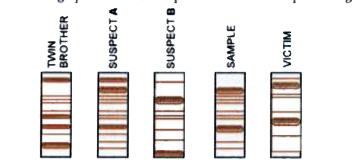
Do you consider the twin brother could possibly be the murdererView SolutionDuring a murder trial two suspects appeared before court . After an investigation (which included DNA fingerprinting) the available evidence proved that suspect A was the murderer. This suspect said that the he was innocent and that his identical twin brother , still on the loose, was in fact the guilty person. His twin brother was subjected to DNA fingerprint tests. Study the DNA fingerprints of hair samples and answer the questions given below:
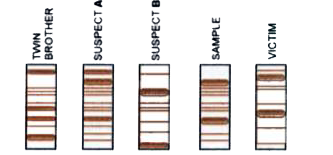
Is it true that the suspect and his twin brother are identical twins ? Give reason.View SolutionDuring a murder trial two suspects appeared before court . After an investigation (which included DNA fingerprinting) the available evidence proved that suspect A was the murderer. This suspect said that the he was innocent and that his identical twin brother , still on the loose, was in fact the guilty person. His twin brother was subjected to DNA fingerprint tests. Study the DNA fingerprints of hair samples and answer the questions given below:
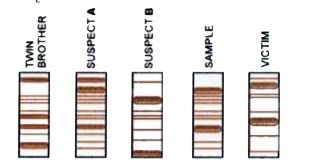
Which suspect would you arrest for the murder if you were the investigating officer ? Motivate.View SolutionHydocarbons, obtained from coal and coal tar and from oil and gas wells, are organic compounds composed entirely of C and H. A 0.1647g sample of a pure hydrocarbon was burned in a C−H combustion train to produce 0.4931g of CO2 and 0.2691g of H2O. Determine the masses of C and H in the sample and the percentages of these elem ents in the hydrocarbon.
Strategy:
Step 1. Use the observed mass of CO2 to determine the mass of C in the original sample using the information that there is 1mol of C atoms in each mole of CO2.
Step 2. Use the observed mass of H2O to calculate the mass of H in the original sample using the fact that there are 2mol of H atoms in each mole of H2O. (We can also calculate the mass of H by subtracting the mass of C from the mass of sample. However, it is good experimental practice, when possible, to base both on experimental measurements as this would help to check for errors in the anlysis of calculation.)
step 3. Calculate the percentages by mass of each element in turn, using the relationship
% Element =Gram of elementGram of sample×100%View SolutionA seminar was held in New York on the problems of finance. Its topic was ' The Different Finance Sources available at the Global Level in the Modersn Context . ' 200 representatives from different countries participated in this seminar. All the representatives expressed their respective opinions. One of the sources of finance discussed in the seminar was such through which the foreign companies could issue their securitiers in India. Looking at the great possibilities of obtaining capital from the investor in India, all of them showed a great interest in the discussion of the source. Another source of finance which created interest in every one was the source through which money could be obtained from the investors in America and other Wuropean countries. Since this sources was concerned with a very big area, the number of people who took interest in it was also larger. One of the Indian representatives threw light on the special characteristics of this source. His presentation was appreciated by one and all . In the final seesion of the seminar, the discussion took place on such a source of finance which could be used only in America . In the end of the seminar , the organisers thanked all the guests, and the seminar came to a successful conclusion.
In the above paragraph , three international sources of finance were discussed. Quoting the relevant lines identify those sources and explain them .View Solution

